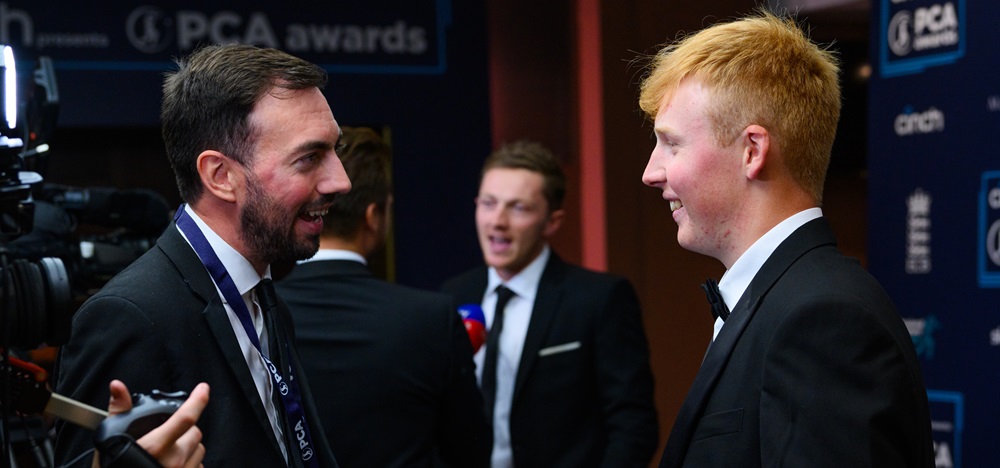

PPF Communications Committee Chair Luke Reynolds joined the PCA in 2013 initially in the role as Social Media Executive. He has since progressed working across all departments and now leads a team of four as Head of Communications. We look at the key priorities and challenges and how the Communications Committee is working together to develop best practice and increase knowledge and collaboration between members.
How did you develop your career in sports Communications?
I was always passionate about sport and determined to work in the industry from a really young age. I got my first break aged 16 when I was on a Leeds Rhinos fan forum and Yorkshire Radio were asking for fans to go on and talk about the season from a fan’s perspective. I then went on to get work experience there doing reports, being part of commentary teams and acting as support staff on live interviews in both rugby league and cricket. At the same time I was studying sports journalism and media at the University of Huddersfield before I got my first full time job working for Wakefield Wildcats. I really loved that role and it exposed me to a lot before applying for the PCA role as Social Media Executive in 2013. At that time, the PCA didn’t have a full time Comms role and so I worked hard to prove myself and gain the trust and backing of various CEOs over the years, expanding the comms remit and building a team that we have in place today.
What have been the main challenges you’ve faced?
Managing the transition into the wider role was a challenge, I knew how forward thinking we needed to be and was aware of the importance of digital media and needed to get everyone on board so we could drive the communications strategy forward. The pandemic was also a hard time, the rest of the team was on furlough at a time when comms was needed more than ever with players so unsure of finances and the media asking questions about players donating money to the NHS. I was dealing with really significant news stories on my own, based at home but it was a great learning experience and now of course we’re set up to manage communications like that remotely if needed.
What do you most enjoy in your role?
Probably the member interactions, it’s really important as player associations to have strong relationships with members. We want to help the game and specifically players and former players so it’s a privilege to do personal and delicate interviews with players that we’ve supported and who trust us to tell their stories. Comms is a small part of the cog but it’s crucial in showcasing the support we provide especially through the Cricketers’ Trust and seeing the fruits of the work we do as a wider team is really satisfying.
How do you envisage Communications developing in the future?
It’s all about evolving according to what members need. Every sport is constantly moving, but it’s fair to say no other sport has moved as quickly as cricket in terms of the global landscape in recent years. The opportunities for all cricketers, not just England players but across the domestic scene is huge. They now have the opportunity to play overseas which means we need to communicate all year round and often at times when they’re abroad as they don’t have as much support from friends and family. They may be satellited into tournaments and often can be on the bench, it can be lonely so communications is key. We also need to have a bigger focus on conveying how players are feeling and having that strong voice to really hammer home how players are finding life as a professional cricketer, whether it’s to the media, governing body or the government.
How does the PPF Communications Committee work together?
The PPF Committee meetings are so valuable for all associations, to have the ability to share best practice with each other and discuss problems, issues, learnings that everyone’s experienced. Ultimately we’re all in similar roles, regardless of size, and hopefully there’s things we can all learn. It’s also not just about getting together but building your own relationships and having conversations away from meetings which are equally valuable. Just recently for example, I’ve liaised with the PGA and the PFA around website resources and communication strategies.
What are the key areas that you tend to focus on across sport?
Working with agencies, communication strategies and how to improve member communications with digital content are recurring themes. We all have to be more sophisticated and evolve to the needs of players’ lifestyle when they are busier than ever so when we try new things it’s really useful to feedback the pros and cons. How we communicate to stay relevant over the next 5, 10 or 15 years is so important.
How can collaboration with other sports help everyone?
We have found with some of the awareness work we’ve done in career transition, women’s sport, mental wellbeing and inclusion that it’s really effective when sports come together to support the common goal and that our reach can be greater when a combination of sports come together and the media, governing bodies and even government stand up and take notice. Having different athletes actually in the room talking about these topics at key times means that they are listened to more and that is really effective communication.